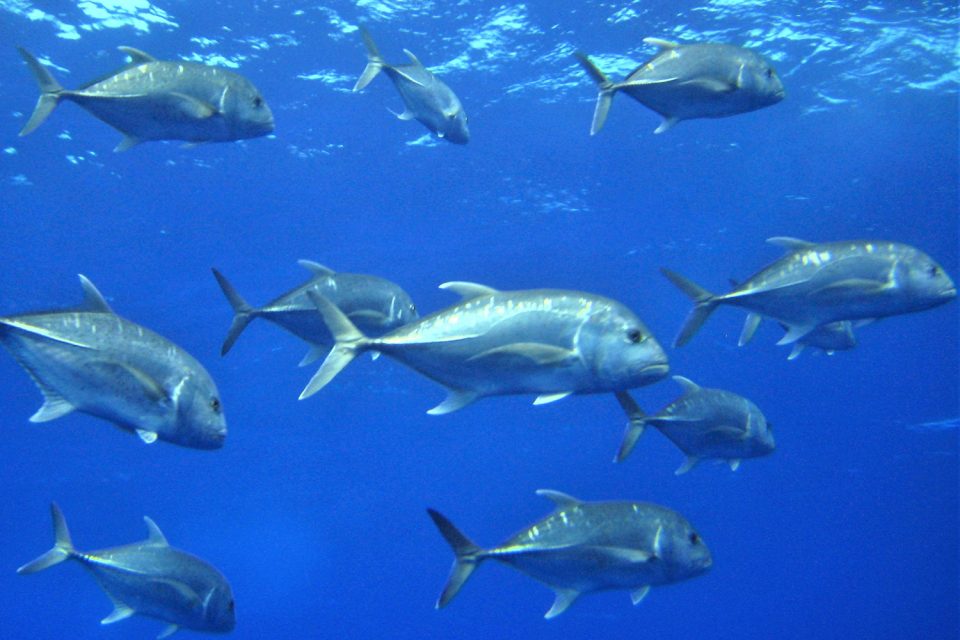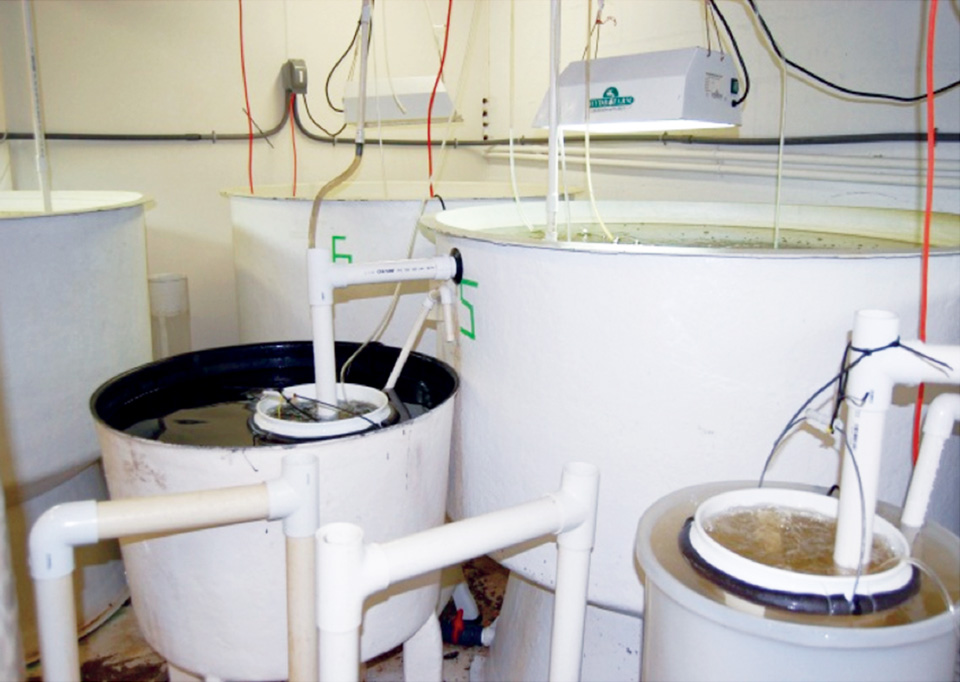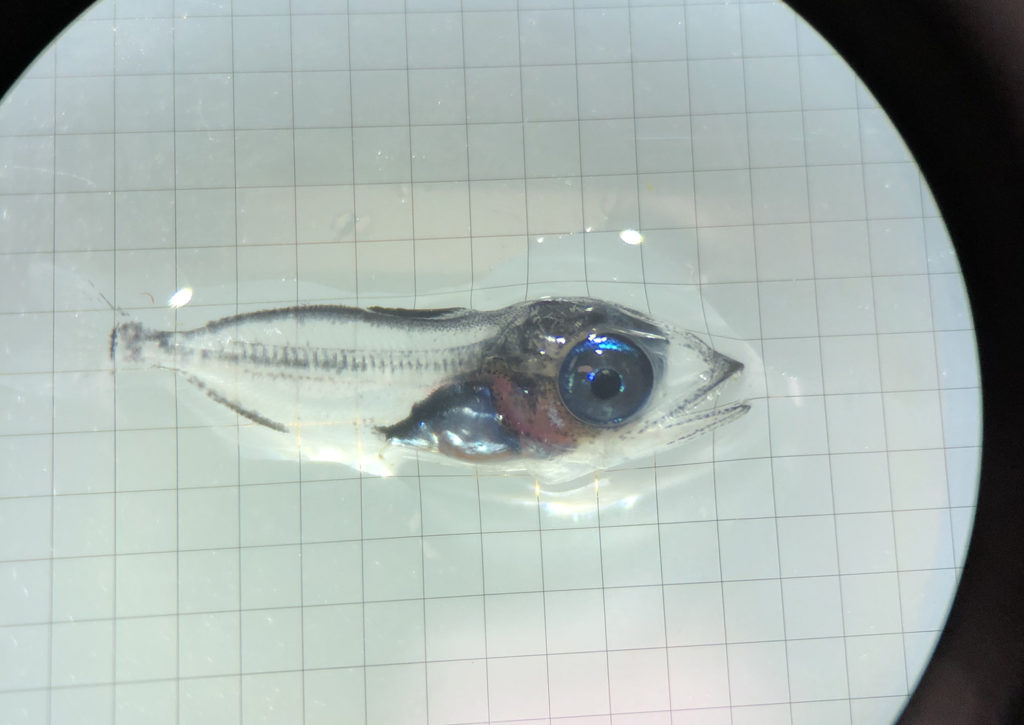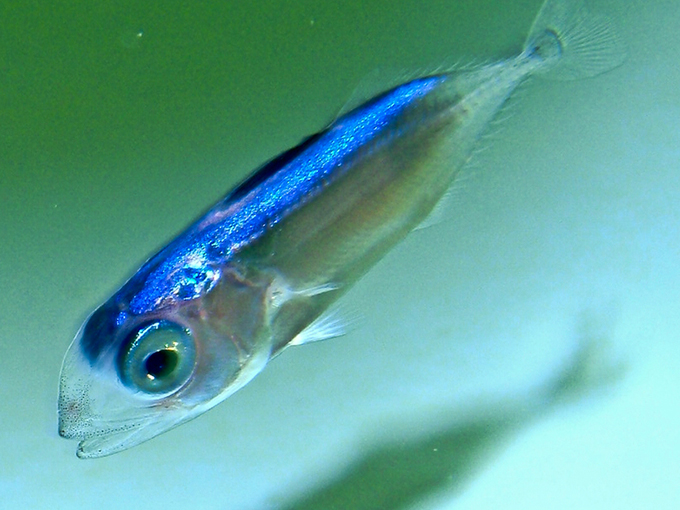Generating important nutritional data to improve formulated feeds for a fish species with significant aquaculture potential

The trevally (Caranx spp.) is an important commercially aquacultured genus in the family Carangidae. One hundred forty-six trevally species have been recorded in the world distributed in tropical, subtropical and temperate marine waters. They are carnivorous and prey mostly on pelagic fishes, crustaceans and cephalopods. The giant trevally (Caranx ignobilis) is likely the largest species in this genus and has been commercially cultured in Vietnam because it grows fast, fetches high market prices and well adapts to sea-cage farming.
Currently, trash fish is still the main feed for giant trevally in Vietnam, leading to high risks of environmental pollution, pathogen introduction and unsustainability due to unstable supply. There are no specific formulated feeds for giant trevally because of the lack of information on its nutritional requirements. Thus, nutritional information key for the production of balanced formulated feeds for giant trevally is a first and essential step towards its sustainable farming.
Determining the optimum protein requirement is crucial to establish cost-effective and balanced diets for the species. A balanced protein/energy (P/E) ratio in aquafeeds is a top priority in fish nutritional studies. P/E ratios have been reported for several marine carnivorous fish such as pompano or permit (Trachinotus falcatus), Asian sea bass (Lates calcarifer), Florida pompano (T. carolinus) and kingfish (Seriola lalandi). But protein and lipid requirements for the optimal growth of juvenile giant trevally are not well documented.
This article – summarized from the original publication [Nguyen, M-N. et al. 2022. Effects of dietary protein and lipid levels on growth performance, feed utilization and body composition of juvenile giant trevally (Caranx ignobilis Forsskal, 1775). Aquaculture Research 2022; 00:1–10] – reports on research to assess the effect of protein and lipid levels with different P/E ratios on growth, feed utilization and body composition for juvenile giant trevally.
Study setup
We conducted an eight-week feeding study to assess the effects of dietary protein and lipid levels on growth, feed utilization and body composition of juvenile giant trevally. The fish were procured from a marine fish hatchery located in Nha Trang (Khanh Hoa, Vietnam) and transferred to the laboratory at the Research Institute for Aquaculture No. 3, Nha Trang, Vietnam. After an acclimating period, the fish (2.12 ± 0.05 grams initial mean weight) were randomly distributed into 18 250-liter fiberglass tanks at 30 individuals per tank (six groups with three replicates) in a flow-through system.
Six experimental diets were prepared with three dietary protein levels (42, 47 and 52 percent) and two lipid levels (10 and 18 percent), labeled as P42:L10, P42:L18, P47:L10, P47:L18, P52:L10, and P52:L18. Fishmeal was used as the main protein source. The corresponding calculated protein-to-energy (P/E) ratios for the diets were 20.23 grams per MJ [a megajoule, MJ, is a unit of energy in the International System of Units], 18.73 g/MJ, 22.31 g/MJ, 20.81 g/MJ, 24.63 g/MJ and 22.12 g/MJ, respectively.
During the experiment, water temperature, salinity, pH, dissolved oxygen and total ammonia were maintained in suitable ranges of 29.5 ± 2 degrees-C, 31 ± 1 ppt, 7.8 ± 0.2, 6.5 ± 0.3 mg/L and <0.5 mg/L, respectively.
For detailed information on the experimental design and fish husbandry; diet preparation; collection of samples and chemical analyses; and statistical analyses, refer to the original publication.
Efficacy of saturated lipids in juvenile California yellowtail feeds
Results and discussion
At all dietary lipid levels, final body weight (FBW) and specific growth rate (SGR) of juvenile giant trevally improved with increasing dietary protein from 42 percent to 52 percent as reported for other carnivorous fish that require high levels of adequate quality protein for growth. Fish exhibited the highest growth performance with the P52:L10 diet, thus suggesting that the diet containing 52 percent protein and 10 percent lipid with a P:E ratio of 24.63 g/MJ is the best diet for the growth of juvenile giant trevally. Similar results have been published for other related species like Florida pompano (T. carolinus).
Increasing lipid levels in the experimental diets, from 10 to 18 percent in the 52 percent protein diets, contributed to a decrease in the growth performance of fish, suggesting that 18 percent lipid is excessive for giant trevally fed 52 percent protein diets. A slight protein sparing for energy occurred for the 42 percent protein diets, where the SGR improved with increasing dietary lipid from 10 to 18 percent. In low-protein diets, increased energy from non-protein sources is likely to spare protein allocation for growth and maintenance. Protein sparing by energy, sourced from lipids, has been reported in several fish species.
Carnivorous fish can easily digest energy from lipid sources rather than from carbohydrates; however, excess dietary lipids can lead to a decrease in fish growth performance. Our results showed that 18 percent was an excessive lipid level for juvenile giant trevally fed the 52 percent protein diets. The excess dietary lipid levels could inhibit the de novo synthesis of fatty acids and decrease their absorption.
Our data also showed increased whole-body protein by the increase in dietary protein and lipid levels, indicating high dietary protein improved the protein synthesis in fish tissues, and that high lipid levels provided more efficient utilization of dietary protein for protein synthesis, evidence of the protein-sparing effect of energy. Comparable results of an increase in whole-body protein with improved dietary protein have been reported for some groupers and other marine fish species.
The whole body lipid value was significantly influenced by the interaction between dietary protein and lipids, as high protein and lipids resulted in high lipid accumulation. Fish fed 52 percent protein and 18 percent lipid diet had the highest body fat composition. But excessive lipid accumulation can affect the health status of the animals due to the possible link to changes in some enzymes. Higher lipid deposition in the liver can lead to negative effects on the health of fish, resulting in higher levels of oxidative stress.
Muscle amino acid profiles may be influenced by the quality of feeds, for example, protein content. Our different experimental diets affected amino acid levels in the fish: the P52:L10 diet resulted in the highest levels of the amino acids isoleucine, lysine, methionine and threonine; fish fed the 52 percent protein diets had higher leucine, valine, arginine, alanine, aspartic acid, glutamine and serine levels than lower dietary protein, whereas the 10 percent lipid diets contributed to increased levels of leucine, valine and arginine, alanine and glutamine in the whole body.
Perspectives
Based on our study results, growth performance in terms of body length, final body weight and specific growth rate for our experimental juvenile giant trevally were the highest when the fish were fed the diet with P52:L10 and P/E of 24.63 g/MJ. The same diet also resulted in the highest effective feed utilization in terms of feed intake and feed conversion ratio. Whole-body crude protein increased when dietary protein or dietary lipid increased from 42 to 52 percent, and from 10 to 18 percent, respectively.
Now that you've reached the end of the article ...
… please consider supporting GSA’s mission to advance responsible seafood practices through education, advocacy and third-party assurances. The Advocate aims to document the evolution of responsible seafood practices and share the expansive knowledge of our vast network of contributors.
By becoming a Global Seafood Alliance member, you’re ensuring that all of the pre-competitive work we do through member benefits, resources and events can continue. Individual membership costs just $50 a year.
Not a GSA member? Join us.
Author
-
Dr. Minh Chau Nguyen
Corresponding author
Faculty Engineering and Science, Curtin University Malaysia, Miri, Sarawak, Malaysia; and Research Institute for Aquaculture No. 3, Nha Trang, Vietnam[121,109,46,117,100,101,46,110,105,116,114,117,99,46,100,97,114,103,116,115,111,112,64,110,101,121,117,103,110,46,117,97,104,99,104,110,105,109]
Related Posts

Health & Welfare
Advances in intensive copepod production technology
Research at the Oceanic Institute has been successful in overcoming bottlenecks associated with rearing small-mouthed fish larvae by finding a suitable first feed. Early work on the calanoid copepod Parvocalanus crassirostris focused on parameters necessary for successful maintenance of stock cultures.

Aquafeeds
A look at phospholipids in aquafeeds
Phospholipids are the major constituents of cell membranes and are vital to the normal function of every cell and organ. The inclusion of phospholipids in aquafeeds ensures increased growth, better survival and stress resistance, and prevention of skeletal deformities of larval and juvenile stages of fish and shellfish species.

Innovation & Investment
‘Not convinced it can’t be done’: A look inside California’s new bluefin tuna hatchery
San Diego-based bluefin tuna hatchery and feed company Ichthus Unlimited aims to make tuna ranching a more sustainable and reliable option.

Innovation & Investment
Tuna aquaculture: Fishing for progress
Aquaculture could be a sustainable alternative to fishing for tuna but achieving commercial-scale production has proven challenging.



